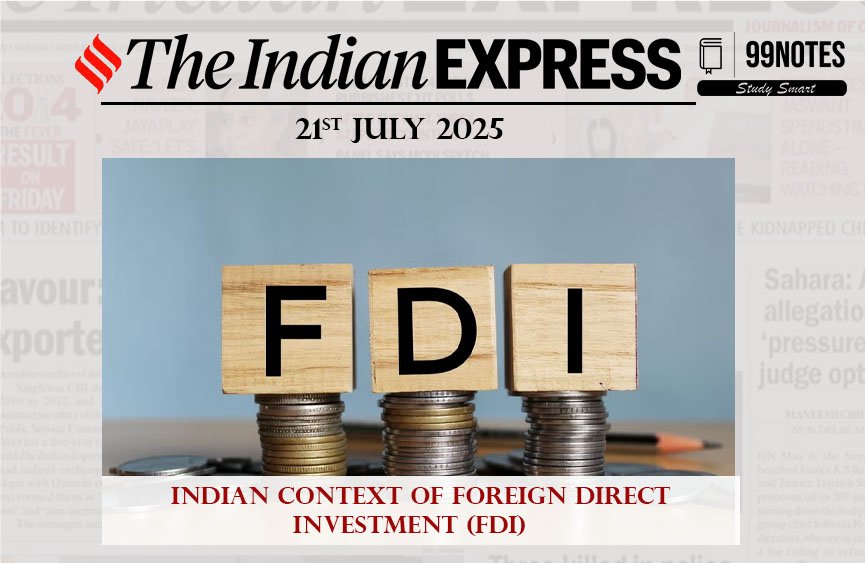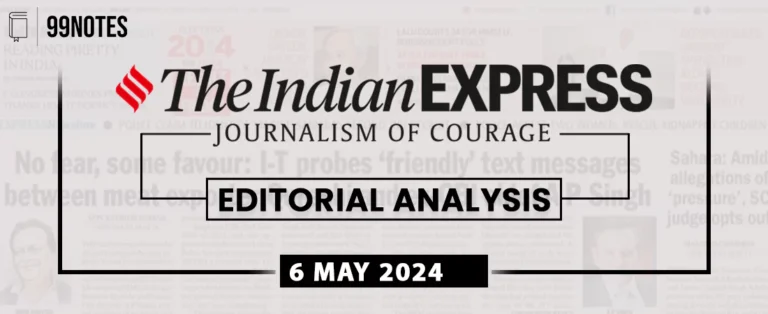21 July 2025: Indian Express Editorial Analysis
1. Unlocking Investment
(Source: Editorial Page, The Indian Express)
| Topic: GS3 (Economy: Investment, FDI, Growth), GS2 (Governance: Policy-Making, Reforms), GS1 (Society: Development), GS4 (Ethics in Policy and Governance) |
| Context |
|
Introduction
FDI has long been a key engine for economic growth in developing nations, driving capital formation, technology transfer, and job creation. However, recent years have witnessed a marked decline in FDI inflows, especially among EMDEs, signaling a shift in investor appetite amid global uncertainties and rising competition for capital.
Global Trends in FDI
-
EMDEs have seen FDI as a percentage of GDP fall over the past decade.
-
In 2023, EMDEs received $425 billion in FDI, the lowest since 2005.
-
Number of new greenfield FDI projects fell sharply between 2010 and 2024.
Causes:
-
Global financial crises, protectionism, and cross-border investment restrictions.
-
Rising returns in developed nations attract capital away from EMDEs.
India’s FDI Position
India is relatively better placed but not immune:
- In FY25, FDI inflows rose to $81 billion, yet net FDI fell 96% due to higher repatriations and lower reinvestment.
- Slowing momentum: Only 380 new investment proposals in 2024, less than half the 2010s average.
Fluctuating FDI impacts:
- Volatile inflows affect economic growth, technology adoption, and employment opportunities.
Policy and Structural Challenges
-
Regulatory uncertainty, frequent policy changes, and slow dispute resolution deter investors.
-
High compliance burdens, complex taxation, and lack of sectoral clarity weigh on business confidence.
-
Need for an overarching, consistent investment framework that assures rule of law and protection of investors’ interests.
Imperatives for Unlocking Investment
Regulatory Reform
-
Rationalize compliance requirements, cut red tape, and clarify tax structures.
-
Deregulation and a stable, investor-friendly policy environment are essential.
Human Capital and Infrastructure
-
Invest in education, skilling, and logistics to improve the quality of the workforce and reduce bottlenecks.
-
Upgrade digital and physical infrastructure to attract global firms.
Trade Policy Coherence
-
Harmonize trade policies with investment goals to ensure predictability.
Institutional Strengthening
-
Empower institutions like the Deregulation Commission for faster, more transparent policy rollouts.
-
Enhance dispute resolution mechanisms for investor grievances.
Sectoral Focus
-
Incentivize FDI in emerging sectors (renewables, digitisation, manufacturing) where global demand is robust.
India’s Way Forward
-
Adopt a proactive strategy to attract and nurture investments.
-
Provide incentives for reinvestment and discourage outflows/repatriations by improving the domestic business environment.
-
Move from short-term fixes to long-term capacity building in policy, institutional design, and infrastructure.
Conclusion / Way Forward
Unlocking greater investment requires more than temporary fixes; it demands a systematic overhaul of India’s policy, regulatory, and institutional landscape. By fostering consistency, improving the business environment, upgrading infrastructure and human capital, and ensuring transparency, India can attract long-term, quality investments and translate them into equitable growth and job creation.
| Practice Question: (GS-2 | 15 Marks | 250 Words)
Despite India’s relatively strong position, FDI inflows have slowed and project proposals have declined sharply in recent years. Discuss the structural barriers hindering FDI in India and suggest comprehensive measures the government should adopt to unlock sustained investment and ensure long-term growth. |
Also Read: The Hindu Editorial Analysis- 21 July 2025
2. Not So Private
(Source: Editorial Page, The Indian Express)
| Topic: GS2 (Polity & Governance, Fundamental Rights, Judiciary); GS3 (Technology, Digital Era Challenges); GS4 (Ethics); GS1 (Society & Family Issues) |
| Context |
|
Introduction
The Supreme Court’s judgment allows the use of covertly recorded conversations as evidence in disputes between spouses, settling conflicting approaches earlier seen in different High Courts. The decision reflects a judicial balancing act between the right to privacy and the right to a fair trial, testing how fundamental rights adapt to technology and modern relationships
Evolution of Spousal Privilege and Privacy
Legal Tradition:
- Section 122 of the Indian Evidence Act, 1872, codifies spousal privilege: generally, neither spouse can be compelled to disclose communications made during marriage.
- Exception: The statute allows such communications as evidence in disputes between married persons or in relevant criminal proceedings.
Modern Challenge:
- Courts have been cautious about allowing secretly recorded evidence due to the strong expectation of privacy in marriage.
- Digital devices now make clandestine recording easy, blurring lines between evidence gathering and privacy invasion.
Supreme Court’s Ruling
Admissibility of Secret Recordings:
- The Court held that such recordings can be admitted as evidence in matrimonial cases, overturning a previous High Court order that privileged privacy over evidence.
- Justification: Where trust has broken down (as in divorce/cruelty suits), the act of recording is itself evidence of marital discord.
Balancing Rights:
- The decision recognizes the right to privacy but asserts it is not absolute—especially when weighed against the right to a fair trial and uncovering truth in judicial proceedings.
- The ruling emphasizes that privacy claims cannot override justice when two private citizens are in litigation, a subtle departure from Supreme Court verdicts that have interpreted privacy as having horizontal as well as vertical applicability.
Digital Era and the Changing Nature of Evidence
Technological Impact:
- From CCTV, emails, chat records, and now secret phone audio, evidence-gathering has become more invasive, especially in private spaces like the home.
- The phone, as the Court noted, now works much like a modern wiretap.
Policy & Gender Concerns:
- Differential access to technology, especially among genders, could bias outcomes.
- Lawmakers must reconsider and possibly update statutes to keep pace with these digital realities.
Right to Privacy in India – Constitutional and Ethical Dimensions
Constitutional Background:
- The landmark K.S. Puttaswamy judgment (2017) established privacy as a fundamental right under Article 21 (right to life and personal liberty).
- The present ruling limits privacy’s scope between private individuals in matrimonial disputes but does not dilute its significance as a constitutional shield against the state.
Ethical Dilemma:
- The core ethical question: Does the pursuit of truth in family law cases justify private surveillance? How should courts weigh dignity and autonomy versus judicial fact-finding?
Conclusion / Way Forward
-
This ruling signals a shift in how privacy is protected in the digital era, particularly within intimate relationships.
-
The judgment indicates the need for strong, clear data protection laws and legislative re-examination of spousal privilege.
-
As technology evolves, trial courts must scrutinize evidence authenticity and balance fairness with constitutional privacy obligations.
-
For future reforms, particular attention should be given to gender equity in access to technology, and updating statutes to match digital realities and ethical expectations.
|
Practice Question: (GS-3 | 10 Marks | 150 Words) |
Read more – 19 July 2025 : Indian Express Editorial Analysis


